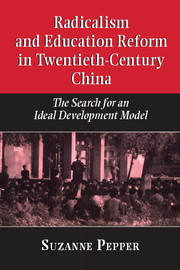Book contents
- Frontmatter
- Contents
- Acknowledgments
- 1 Educational development and the Chinese experience
- Part I The republican era: origins of radical education reform
- Part II Learning from the Soviet Union
- Part III Cultural revolution and radical education reform
- 11 On Stalin, Khrushchev, and the origins of cultural revolution
- 12 The great leap in education
- 13 A system divided: walking on two legs into the 1960s
- 14 Education reform as the catalyst for cultural revolution and class struggle: the 1966–1968 mobilization phase
- 15 Education reform as the culmination of class struggle: the professional educator's perspective
- 16 Education reform as the culmination of class struggle: the critical ideals triumphant at last
- 17 The Cultural Revolution negated
- 18 The mixed triumph of regularity
- 19 Chinese radicalism and education development
- Appendix: the Hong Kong interviews
- Select bibliography
- Index
11 - On Stalin, Khrushchev, and the origins of cultural revolution
Published online by Cambridge University Press: 04 August 2010
- Frontmatter
- Contents
- Acknowledgments
- 1 Educational development and the Chinese experience
- Part I The republican era: origins of radical education reform
- Part II Learning from the Soviet Union
- Part III Cultural revolution and radical education reform
- 11 On Stalin, Khrushchev, and the origins of cultural revolution
- 12 The great leap in education
- 13 A system divided: walking on two legs into the 1960s
- 14 Education reform as the catalyst for cultural revolution and class struggle: the 1966–1968 mobilization phase
- 15 Education reform as the culmination of class struggle: the professional educator's perspective
- 16 Education reform as the culmination of class struggle: the critical ideals triumphant at last
- 17 The Cultural Revolution negated
- 18 The mixed triumph of regularity
- 19 Chinese radicalism and education development
- Appendix: the Hong Kong interviews
- Select bibliography
- Index
Summary
Much as the regular modes of Chinese education co-opted the initial Stalin model, so Khrushchev's attempt to reform that model in the Soviet Union was soon taken over in China by a new strain of Chinese radicalism. China's 1958 Great Leap Forward marked that takeover. But the syncretism contained within it was obscured by the developing Sino-Soviet rift and the CCP's need to neutralize its embarrassing new image as a mechanical copier. Unfortunately, much of the evidence for this line of reasoning is only circumstantial. But once mustered, this evidence suggests that the Chinese debt to Khrushchev, and Mao's debt to Stalin before him, were substantial enough to warrant some adjustments in the conventional interpretation.
In China, the radicalism began with Mao's “great stride” of 1956 and continued two years later as the even more ambitious Great Leap Forward. This adventure in high-speed socialist development included extensive education reforms introduced in 1958 as part of a “cultural revolution.” The radical education reforms introduced that year were then reincarnated in the Great Proletarian Cultural Revolution of 1966–1976, which sought to combine and institutionalize the earlier radical adventures as essential features of an evolving Chinese communism.
According to conventional periodization, moreover, the 1958 leap marked the end not just of mechanical copying but also of direct Soviet influence. Thereafter, China set out self-consciously in search of its own distinct route to socialism, which culminated in the 1966–1976 Cultural Revolution.
- Type
- Chapter
- Information
- Radicalism and Education Reform in 20th-Century ChinaThe Search for an Ideal Development Model, pp. 259 - 277Publisher: Cambridge University PressPrint publication year: 1996
- 2
- Cited by



